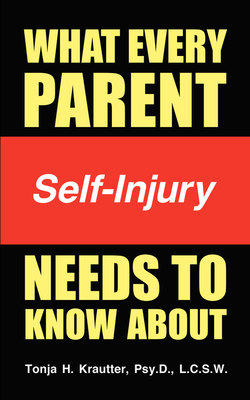Читать книгу What Every Parent Needs to Know About Self-Injury - Tonja Krautter - Страница 21
На сайте Литреса книга снята с продажи.
ОглавлениеIdentifying Self-Injury
“Cutting became my cry for help when words could not do it for me. I don’t think I would have stopped if my coach hadn’t noticed. She picked up on the warning signs and identified the problem. Only then did I get the help I so desperately needed but could not ask for.” - Jessica, age 15
Perhaps you are reading this chapter because your teen self-injures, or maybe you know someone else that does. Maybe you are reading it because you have suspicions that your child is engaging in self-harming behaviors. In any case, I would like to applaud your willingness to examine the problem and identify the severity of your child’s situation. With self-injury is becoming as widespread as substance abuse and eating disorders, it is not uncommon for most people to know someone who struggles with this problem. Yet parents generally have little information as to what they can do to help. The first step is identifying the problem and simply acknowledging that it exists.
In the past 18 years, I have worked with more individuals who self-injure than I can count. What was once thought of as a teenage phenomenon is now recognized as a struggle faced by individuals of all ages. It may surprise you to know that the incidence of habitual bodily harm is approximately 1% in our country. With a reported 2 million cases in the United States alone, it is clear that this disorder has become rampant and affects a diverse population. This number is growing at a fast rate and there is evidence it is beginning to occur among younger and younger individuals.
While some of the individuals that have walked into my office have been as young as nine, it is still more common among teenagers. If left untreated, this behavior often continues into adulthood. In addition, the longer the individual struggles with the problem, the harder it is likely to be for them to stop the behavior. Therefore, getting help as soon as possible is very important. This is a serious problem that should be treated aggressively when first identified.
Warning Signs
There are several signs that may indicate an individual is engaging in self-injurious behavior. One of the biggest red flags is when the individual always wears long sleeves and pants, even when the weather is warm. Another red flag is frequently unexplained or justified injuries such as scratches, cuts or burns. Amber recalls how she attempted to hide her self-harm from people at school. She states, “My solution was long sleeves and pants, and at soccer practice I cleverly used a sock which I said was a sweat band.” In addition, she remembers having to explain why she had scratches on her body. “I made up crazy stories about my cat to answer some of the questions,” she recalls.
Other warning signs include low self-esteem, a feeling of being easily overwhelmed, difficulty maintaining stable, healthy relationships, and trouble functioning at school, home or work. Although all of these factors may be symptoms, they are not, in and of themselves, direct indicators that self-injurious behavior is present.
